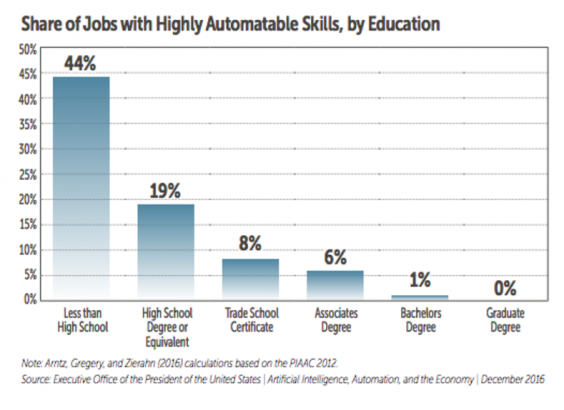Today’s high school students will graduate into a workforce destabilized by technological innovation, according to a new publication from America Succeeds, and even graduates of competitive four-year colleges will have to continually acquire new skills to remain employed in the dawning age of artificial intelligence.
The group, an advocacy organization dedicated to bringing together schools and businesses, argues that American schools have failed to prepare their charges for the jobs they will need to fill in the future.
“Far from making plans to educate students to thrive in the economy and society of the near-term future, most school systems are still struggling to do an adequate job providing students with the basic skills needed for twentieth-century life and work,” they write.
The paper echoes growing fears of a “fourth Industrial Revolution” that could shunt aside blue- and white-collar workers alike in favor of ever-more-capable machines, citing 2013 research from Oxford University academics indicating that nearly half of all American jobs could be threatened by computerization within the next 20 years.
Wholesale implosion of professions like long-haul trucking, paperwork processing, and even auto insurance sales (increasingly obsolete as self-driving vehicles cause fewer road accidents) may lead to millions of displaced workers as soon as 2025.

Paradoxically, even as industries and positions vanish, the study also quotes from a McKinsey analysis projecting a worldwide shortage of 85 million medium- and high-skilled workers by 2020. Although job seekers with only a high school education are “likely to be virtually unemployable,” the authors write, those willing to master new competencies and tack between careers in different fields will be well positioned to thrive in what they dub the “Age of Agility.”
“There is a deeply embedded resistance to agility in the current education system, which demonstrates the need for an overhaul and simultaneously makes it difficult to do so,” they lament. But they also offer recommendations for how to reshape both K-12 and higher education to fortify pupils for a world in which work is briefer, more contingent, and less stable.
With the nation’s white majority tapering off over the next few decades, employers have publicly signaled their preference for applicants comfortable with supervisors, colleagues, and clients of all ethnic backgrounds. To foster cross-cultural familiarity, they call for policymakers to construct “networks of truly diverse schools, through strategically located magnet programs, enhanced transportation between schools, and controlled choice policies designed to promote socioeconomic diversity in as many schools as possible.”
With a whiff of understatement, the study concedes that desegregating school districts “has proved politically challenging in the past.” In reality, U.S. schools are more segregated by race and income today than they were 30 years ago.
Even with individual expertise losing its currency to advanced robotics, schools can still work to instill “soft skills” resistant to mechanical duplication, such as empathy and teamwork. These interpersonal assets could prove more durable than any specific technical training, the authors write, since the pace of automation over the coming years will eliminate countless professional roles in sectors ranging from farming to finance (or at least render them unrecognizable to their current occupants).
“K-12, as well as higher education systems, will have to take longer-term ownership of their students’ futures,” they add. “A career and technical education program won’t be useful if it prepares kids for jobs that are on the verge of vanishing.”
Colleges and universities may have to undergo even more fundamental changes, the study suggests, partnering with businesses to create experiential learning ventures and emphasize in-demand specializations. Most provocative of all, Harvard innovation guru Gordon Jones is quoted musing about the prospect of long-term readmission access — essentially allowing college graduates to return to their alma maters and take on new coursework later in their careers.
And millions of degree holders may find themselves in need of such opportunities. The authors state time and again that the most sought-after trait in their so-called Age of Agility will be a “mindset and practice of lifelong learning”: the willingness of a trained paralegal to turn his analytic skills toward computer science, for example, or an ousted accountant to reimagine herself as a veterinarian.
In the meantime, they conclude, conversations should begin now on how to “restructure — as radically as deemed necessary — the way we deliver education.”
Get stories like these delivered straight to your inbox. Sign up for The 74 Newsletter


;)
